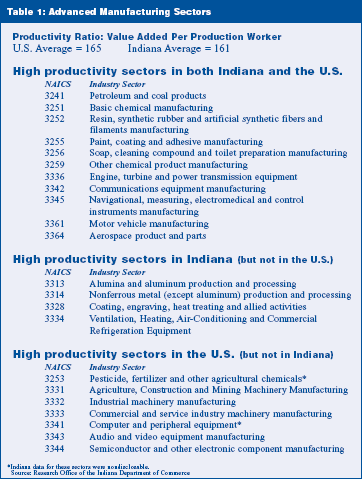The Link Between Advanced Manufacturing and Productivity
| Download spreadsheet for a detailed list of productivity ratios for selected U.S. and Indiana manufacturing sectors. |
Advanced manufacturing: According to James J. Solberg, Purdue University’s Ransburg Professor of Manufacturing, “this phrase connotes progress in virtually every aspect of manufacturing: design methods, process technology, worker skills, organizational structures and management practices. Further, this must take place in all of Indiana’s manufacturing sectors: automotive, food processing, electronics, steel and all the others” (Purdue News, February 26, 2002).
So which manufacturing sectors in Indiana can be classified as advanced manufacturing? While some candidates for advanced manufacturing are self-evident, it is difficult to select the less obvious. Based on productivity factors, the Research Office at the Indiana Department of Commerce has produced a preliminary analysis specifying which business sectors are most likely engaged in advanced manufacturing. The assumption is that sectors engaged in advanced manufacturing are more productive. The productivity ratios are shown as value added per production worker and value added per dollar of production worker payroll (see sidebar). Note that because of their inclusion in the life science industry, pharmaceuticals and other manufactured medical products were not included in this analysis.
Determining Productivity ScoresThe key component in our analysis is the value added by manufacture, considered to be the best value measure available for comparing the relative economic importance of manufacturing among industries and geographic areas. This value is derived by subtracting the cost of inputs (materials, supplies, fuel and electricity) from the value of shipments (products manufactured plus receipts for services rendered). Value added is then divided by two variables—production workers and their wages—to create productivity ratios. Using this value added measure overcomes the dilemma of selecting advanced manufacturing on the basis of either process or product because it incorporates both elements. Some thought was given to using total employment and payroll since it captures all sector aspects. Production worker data, however, was selected because production labor costs receive primary consideration in facility expansion, retention and relocation analyses, and not the salaries linked to management or related areas. An additional byproduct of using production worker data is to see how competitive Indiana wages are compared to the national average. It has often been said that since Indiana manufacturing wages are higher than the U.S. average, Indiana is at a disadvantage in attracting new business. While not true for all sectors, this analysis shows that when Indiana sectors wages are higher than the national average, Indiana’s productivity rates are also higher. |
Results
For manufacturing sectors to be considered advanced manufacturing, they must exceed the average manufacturing productivity ratios at or near the national level, and Indiana sectors must exceed the U.S. ratios. This gives three sets of results:
- Sectors where both the U.S. and Indiana sectors exceed the U.S. average
- Sectors where only the U.S. sectors exceed the U.S. average
- Indiana sectors exceeding the U.S. average
The average U.S. productivity ratios are $165 of value added per production worker and $5.40 per dollar of production worker payroll.
Using these benchmarks, 22 sectors were identified as advanced manufacturing (see Table 1). As expected, all of the chemical sectors had high productivity, as did computer related sectors, communication equipment, aerospace and high-tech electronics (audio/video, navigation equipment, controls, etc.). However, not all electrical and electronics sectors are included. Similarly, many but not all machinery manufacturing sectors are included on the advanced manufacturing list.
Motor vehicle assembly made the list, but not auto parts or any other motor vehicle sector.
Two sectors that may be a slight surprise are paint, coating and adhesive manufacturing and soap, cleaning compound and toilet preparation manufacturing. It bears remembering, however, that both sectors belong to the chemical industry.
Three metal sectors show lower productivity at the national level but have high productivity in Indiana. This helps illustrate that high productivity varies within industry categories. Not every business or subsector on this advanced manufacturing list will have high levels of productivity. The petroleum and coal products sector is on the list, but subsectors in this industry range from asphalt shingle production to petroleum refineries.
Summation
This list is not intended to be a final definitive list of advanced manufacturing in Indiana. The analysis was used to quantify a core group of industry sectors with the highest levels of productivity. Each of these sectors will have subsectors that have varying degrees of productivity. Although most probably have high levels of productivity, some will not. In turn, there may be subsectors of unlisted industries possessing high levels of productivity. For example, wet corn milling, included with the grain oilseed milling industry, may not sound like advanced manufacturing. However, this industry converts corn to products such as glucose, dextrose, fructose and many other products; in a way, it is more like a chemical industry than one in agricultural manufacturing.
As productivity levels change over time and more (and better) data become available to analyze different industries, this list will change. Additional industries may be added to the list provided some type of quantifiable evidence demonstrates their claim to being classified as advanced manufacturing.
Ted Jockel
Senior Economist, Research Office of the Indiana Department of Commerce

